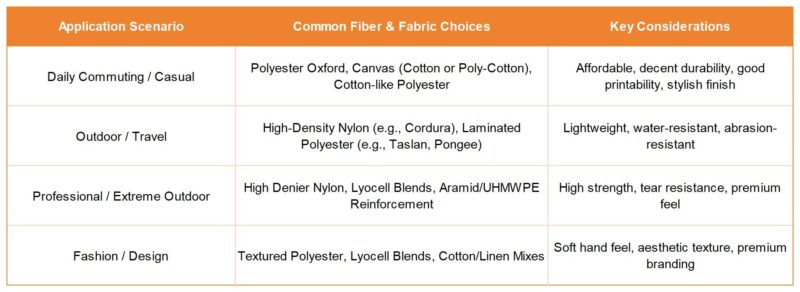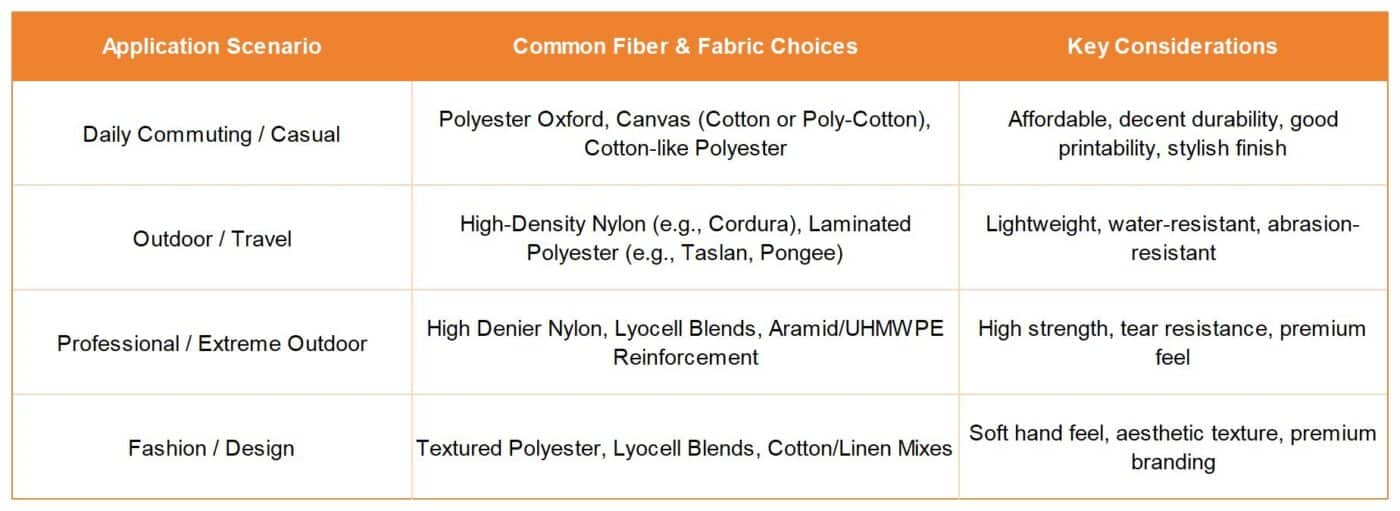Enterprise News
Types of Fibers Used in Backpack Fabrics: A Guide from a China-Based Manufacturer
1. Fiber Classification Of Backpack Fabrics?
When selecting backpack fabrics, fiber type is the core factor determining their performance (such as strength, abrasion resistance, weight, water resistance, hand feel, environmental friendliness, cost, etc.). Fibers used in backpack fabrics can be broadly categorized as follows:
I. Natural Fibers
- Cotton:
- Advantages: Natural, breathable, absorbent, comfortable, biodegradable, good hand feel.
- Disadvantages: Relatively low strength (especially when wet), prone to wrinkling, shrinkage, slow drying, relatively heavy weight, moderate abrasion resistance, susceptible to mildew.
- Application: Commonly used in casual backpacks, canvas bags, and backpacks emphasizing eco-friendliness and natural style. Often treated with wax or blended with synthetic fibers to improve durability and water resistance.
- Bast Fibers (Linen, Jute, Hemp, etc.):
- Advantages: Very strong (in dry state), good moisture absorption and breathability, naturally antibacterial, biodegradable, unique texture, eco-friendly (especially hemp).
- Disadvantages: Rough hand feel, prone to wrinkling, poor drape, low elasticity, significant loss of strength when wet.
- Application: Rarely used as the main fabric; more common for decorative elements or specific eco-conscious backpack styles (especially hemp). Jute is often used as a base fabric for low-end bags.
- Wool:
- Advantages: Excellent warmth, moisture-wicking, good elasticity, wrinkle-resistant, relatively flame retardant.
- Disadvantages: Heavyweight, prone to shrinkage (felting), susceptible to moths, higher cost, moderate strength, slow drying.
- Application: Very uncommon for the main body of ordinary backpacks. May be used for thermal linings in winter outdoor packs or as accents in high-end, specially designed backpacks.
II. Chemical Fibers (Synthetic Fibers)
These are the mainstay of modern backpack fabrics due to their superior performance and controllable cost.
- Polyester Fiber:
- Advantages: High strength, high abrasion resistance, wrinkle-resistant, quick-drying, low shrinkage, chemical resistant, excellent lightfastness, low cost. Easily treated for various functionalities (e.g., coatings, laminates).
- Disadvantages: Poor moisture absorption (can feel clammy), prone to static, can feel stiff, difficult to dye (requires high temperature/pressure), not biodegradable.
- Application: One of the most common and mainstream backpack fabric fibers.** Widely used in all types of backpacks, from daily commuting to professional outdoor gear. Often appears in different specifications (e.g., filament, spun), weaves (e.g., oxford, taslan, pongee), and finishes (PU coating, PVC laminate).
- Polyamide Fiber (Nylon)::
- Advantages: Extremely high strength and abrasion resistance (better than polyester), good elasticity, lightweight, excellent fatigue resistance, easy to dye, relatively soft hand feel.
- Disadvantages: Moderate lightfastness (can yellow/become brittle with prolonged UV exposure), moderate moisture absorption (slightly better than polyester), usually higher cost than polyester, not biodegradable.
- Application: Primary fabric fiber for high-end and professional outdoor backpacks. Especially suitable for packs needing to withstand high wear and heavy loads (e.g., hiking packs, travel luggage). Common nylons like Nylon 6 and Nylon 66 belong here. Common deniers include 210D, 420D, 500D, 1000D – higher numbers usually indicate thicker, more durable fabric.
- Spandex (Elastane)::
- Advantages: Exceptional elasticity (can stretch 5-8 times its length),** good strength, excellent abrasion resistance, lightweight.
- Disadvantages: Almost never used alone; poor chlorine resistance (swimming pools) and lightfastness; higher cost.
- Application: Almost always blended with other fibers (especially polyester or nylon) to provide superior elasticity and fit for specific parts of a backpack, such as stretch mesh side pockets, shoulder straps, hip belts, and compression straps.
III. Man-made Fibers (Regenerated Fibers)
Fibers regenerated from natural polymers (e.g., wood pulp, cotton linters) through chemical processes.
- Viscose Rayon:
- Advantages: Good moisture absorption, breathable, soft and smooth hand feel, good drape, easy to dye, good luster.
- Disadvantages:Significant loss of strength when wet (very poor resistance to laundering friction), prone to wrinkling, shrinkage, poor abrasion resistance, poor dimensional stability.
- Application: Rarely used alone for backpack main fabric (insufficient strength). May be used for linings, decorative fabrics, or blended to improve hand feel and absorbency.
- Acetate:
- Advantages: Soft, smooth hand feel, good luster, excellent drape, wrinkle-resistant, easy to dye, resistant to pilling.
- Disadvantages: Low strength (especially when wet), poor abrasion resistance, low heat resistance, poor chemical resistance (especially acetone), higher cost.
- Application: Primarily used for backpack linings and decorative elements, providing a good hand feel and appearance.
- Lyocell (e.g., Tencel):
- Advantages: High strength (dry and wet strength close to polyester!), good moisture absorption and breathability, soft and smooth hand feel, excellent drape, natural luster, eco-friendly (solvent recyclable), biodegradable.
- Disadvantages: Prone to fibrillation (surface fuzzing) when wet, higher cost, demanding processing requirements.
- Application: As a higher-performance, more eco-friendly alternative to viscose, increasingly used in mid-to-high-end backpack fabrics, especially by brands pursuing sustainability and good tactile feel. Often blended with synthetic fibers.
IV. High-Performance Specialty Fibers
Used for top-tier backpacks in extreme environments or with special demands.
- Aramid Fiber (e.g., Kevlar):
- Advantages: Exceptional strength, modulus, and abrasion resistance (far exceeding nylon/polyester), excellent heat and flame resistance, lightweight.
- Disadvantages:Extremely expensive, difficult to dye, poor lightfastness (requires protective coating), poor compression recovery.
- Application: Used in professional tactical packs, firefighting packs, racing packs, etc., for areas needing ultimate abrasion resistance, cut resistance, or flame resistance (e.g., pack bottom, high-wear areas).
- Ultra-High-Molecular-Weight Polyethylene (UHMWPE) Fiber (e.g., Dyneema, Spectra):
- Advantages: Extremely high strength (higher than aramid!), good abrasion resistance, extremely lightweight (lighter than water), chemical resistant, low-temperature resistant, hydrophobic.
- Disadvantages: Extremely expensive, relatively poor heat resistance (high melt point but low softening point), moderate creep resistance, difficult to dye, lower cut resistance than aramid.
- Application: Used in top-tier ultralight mountaineering packs, sailing packs, and professional backpacks requiring ultimate strength and minimal weight.
Summary & Key Points1. Mainstream & Core: Polyester and polyamide fibers are the absolute mainstream and core of backpack fabrics. They provide the most fundamental and essential performance requirements: strength, abrasion resistance, light weight, quick drying, easy care, and cost control.
2. Blending Reigns Supreme: A single fiber rarely meets all needs. **Blending technology is widely applied:
Polyester + Cotton: Combines durability with comfort.
Nylon + Spandex: Adds elasticity to abrasion resistance.
Polyester/Nylon + Lyocell: Enhances eco-friendliness and hand feel.
Base Fabric (Polyester/Nylon) + Reinforced with High-Performance Fiber (Aramid/UHMWPE): Used for key high-wear areas.
3. Finishing is Crucial: Fibers are just the foundation. The final fabric performance depends heavily on yarn structure, weaving method (plain, twill, oxford, jacquard, etc.) and, most importantly, finishing processes (e.g., PU coating, PVC lamination, TPU film lamination, waterproof breathable membrane bonding, water-repellent treatments, UV treatments). These processes significantly improve fabric water resistance, tear strength, weather resistance, appearance, and hand feel.

2. Comparison Table: Choosing the Right Fiber
This comparison helps sourcing managers and designers understand the trade-offs between popular backpack fabrics:
Fabric Comparison Table
| Fabric Type | Durability | Water Resistance | Weight | Cost | Eco-Friendliness |
|---|---|---|---|---|---|
| Cotton | Medium | Low | Medium | Low | High |
| Bast Fibers (Linen, Jute, Hemp, etc.) | Medium | Low | Medium | Low | High |
| Wool | High | Medium | High | Medium–High | Medium |
| Polyester Fiber | High | High | Light | Low | Low (can be recycled) |
| Polyamide Fiber (Nylon) | High | High | Light | Medium | Low (energy-intensive) |
| Spandex (Elastane) | Medium | Medium | Very Light | Medium | Low |
| Viscose Rayon | Medium | Low | Light | Low | Medium (semi-synthetic) |
| Acetate | Medium | Low–Medium | Light | Low | Medium (biodegradable) |
| Lyocell (e.g., Tencel) | High | Medium | Light | Medium | High (eco-friendly) |
| Aramid Fiber (e.g., Kevlar) | Very High | High | Light | Very High | Low |
| UHMWPE Fiber | Very High | High | Ultra Light | Very High | Low (hard to recycle) |
Legend
- Durability: Resistance to abrasion, tearing, and long-term wear.
- Water Resistance: Natural hydrophobic properties (not including coatings).
- Weight: Relative heaviness or lightness of the fabric.
- Cost: General market price of raw and finished fabric.
- Eco-Friendliness: Sustainability, biodegradability, and energy consumption in production.

3. Backpack-Specific Applications
Each fiber serves a different purpose depending on the use case:
- Hiking & Outdoor: Nylon or Cordura for abrasion resistance and water repellency.
- School Bags: Polyester for cost-efficiency and color variety.
- Travel Backpacks: Nylon/Polyester blends for balance of toughness and weight.
- Tactical/Military: Cordura or heavy-duty nylon for extreme conditions.
- Promotional Backpacks: Cotton or lightweight polyester for lower cost and branding.
| Application Scenario | Common Fiber & Fabric Choices | Key Considerations |
|---|---|---|
| Daily Commuting / Casual | Polyester Oxford, Canvas (Cotton or Poly-Cotton), Cotton-like Polyester | Affordable, decent durability, good printability, stylish finish |
| Outdoor / Travel | High-Density Nylon (e.g., Cordura), Laminated Polyester (e.g., Taslan, Pongee) | Lightweight, water-resistant, abrasion-resistant |
| Professional / Extreme Outdoor | High Denier Nylon, Lyocell Blends, Aramid/UHMWPE Reinforcement | High strength, tear resistance, premium feel |
| Fashion / Design | Textured Polyester, Lyocell Blends, Cotton/Linen Mixes | Soft hand feel, aesthetic texture, premium branding |

4. Expert Tips from a China-Based Backpack Manufacturer
- MOQ Consideration: Custom fabrics like Cordura may require higher minimum order quantities.
- Lead Time: Nylon variants have shorter lead times compared to blended or waxed cottons.
- Brand Target: Promotional buyers may prefer price over performance—choose polyester.
- Eco Trends: Recycled PET polyester is growing in demand for sustainability-focused brands.
- Color Matching: Polyester holds colors better than nylon under high-heat printing.
5. Frequently Asked Questions
Q1: What is the most durable backpack material?
Generally, Cordura® nylon is the most durable, used for military and tactical gear.
Q2: Which fabric is more eco-friendly: Nylon or Cotton?
Cotton is biodegradable but may require more water during cultivation. Recycled polyester is a strong eco alternative.
Q3: Is polyester waterproof?
Polyester itself is not waterproof, but it can be treated with PU or PVC coatings for water resistance.

